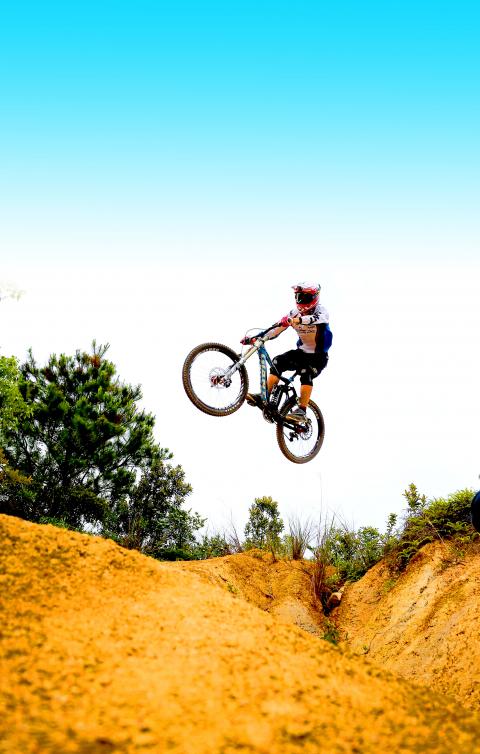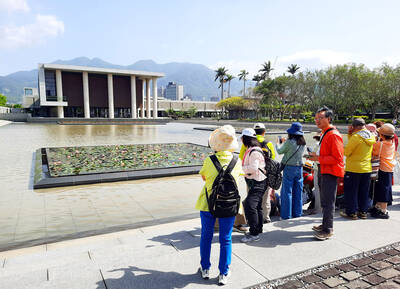On the weekend of April 26 and April 27, Taiwan’s national championship downhill mountain bike races were held in Greater Kaohsiung at Dapingding (大坪頂). Before a sparse crowd of fans, friends, and family, riders from around the country tried to find the fastest line down a short course of jumps, banked turns and natural obstacles, with the winning times clocking in at just under a minute.
Downhill mountain biking has quietly been on the rise in Taiwan since the first formal bike race in the country’s history was held at Dakeng (大坑) in the Greater Taichung area 15 years ago. It was just over a half decade ago that the handful of downhill riders from around Taiwan started moving beyond the online forums where they congregate to chat about their favorite sport and ride together in larger groups. Though still far outside the mainstream, riders such as Dan Chiang (江勝山), 20, who blew away the competition on the men’s side by as much as six seconds at this year’s event, are helping to bring downhill riding to a moderate level of prominence. But it has a long way to go.
“Mountain bike racing is not popular in Taiwan. People don’t understand this sport, so they think it’s dangerous and view it as an alternative sport,” Chiang says.

Photo Courtesy of Ian Chu
GROWING SPORT
Nevertheless, there are several loosely organized and informal downhill riding groups around the nation, with the Northern Taiwan Off-Road crew (北台灣OFF-ROAD團) boasting about 1,500 members online. Of that membership, around 40 to 50 men and women ride regularly. Chiang, somewhat of a poster boy for the Taiwan downhill scene, often rides with the group at Danfeng Mountain (丹鳳山), overlooking the Guandu Plain and the Tamsui River (淡水河) mouth in Taipei’s Beitou District. That’s when he’s not taking part in the irregular races organized around Taiwan, or competing overseas in places as far away as Whistler, British Columbia, where he placed 5th in the junior division of the Canadian Open Downhill competition in 2013.
Chiang is also a full-time sport science student at the University of Taipei (臺北市立大學), where gymnastics classes prepare him for the inevitable falls that are a staple of his adrenaline-fueled sport of choice. Knowing how to crash correctly is a vital component of overcoming the fear that comes with hurtling down a mountainside at 40 kilometers per hour or more. Chiang’s contemporary on the women’s side of the sport in Taiwan, Penny Chou (周佩霓), a two-time gold medalist at the Asian Mountain Bike Continental Championships, knows all about that fear and how to control it.
“When I’m on an unfamiliar track,” says the 30-year-old Greater Kaohsiung born and raised rider, “I may be afraid, but practicing over and over again makes me get used to it. Every time I start, I control my breathing and relax. That makes me confident.”
WATCH THOSE WHEELIES
Both Chiang and Chou speak not only of the mental and physical challenges of downhill mountain biking, but also of those associated with gaining broader acceptance for the sport in Taiwan. Compared to the riders who first started breaking away from the mainstream, that is using a bike for any purpose other than getting from point A to point B, they’ve got it easy.
Yamoon Huang (黃英明), 51, got his start in extreme forms of cycling about 35 years ago when he began ripping around on a bike with dual rear-suspension system, somewhat like a motocross bike without the engine. He took up downhill riding about six years ago, and is now a certified coach. Huang remembers a time when performing even the most basic stunt on a bike was condemned by Taiwanese society.
“When I was a kid, doing a wheelie was unacceptable anywhere by anybody,” he says, adding that getting caught doing such a rudimentary trick, involving nothing more than lifting the front wheel of the bike off the ground, could be enough to get one suspended from school.
Brian Cheng (鄭宇宏), 47, who has been racing downhill for about 15 years, has similar memories of those early days of the precursors of downhill biking. He began riding a BMX bike when he was 12, and had to do so behind his disapproving parents’ backs. One day, while in junior high school, he simply rode his bike to school. Though he didn’t pull any stunts, not even a wheelie, he was treated by teachers as though he were a low-life gangster.
“You must be a troublesome kid to ride a BMX,” he recalls them admonishing him.
CHANGING PERCEPTIONS
Today, attitudes toward downhill biking are slowly starting to change. This is thanks in part to a concerted effort on behalf of the downhill community to inform Taiwanese parents, whom Huang describes conservatively as being “protective,” of the relative safety and benefits of the sport for young people.
There is also an ongoing campaign to foster a good relationship with hikers, with whom downhill riders share many of the hillside trails they use. Conflicts between bikers and hikers have turned nasty before, verbally if not physically. But Bagwell Hsu (徐星吉), 34, who rides regularly with the Northern Taiwan Off-Road group, says he knows why some in the hiking community, which far outnumbers downhill riders, are wary of the subculture.
“Putting myself in their shoes, I understand,” says Hsu. “If I were hiking and someone barged down with a bike, I would get frightened. So that’s why we always say, ‘Slow down, this is not a race. If you see a hiker, stop. Don’t just slow down and pass by. Stop, greet them, then go your separate ways.’”
Huang takes things to a greater extreme when it comes to putting the sport’s best foot forward. “In the worst case scenario, I would choose to run into a tree rather than scare a hiker.”

When the South Vietnamese capital of Saigon fell to the North Vietnamese forces 50 years ago this week, it prompted a mass exodus of some 2 million people — hundreds of thousands fleeing perilously on small boats across open water to escape the communist regime. Many ultimately settled in Southern California’s Orange County in an area now known as “Little Saigon,” not far from Marine Corps Base Camp Pendleton, where the first refugees were airlifted upon reaching the US. The diaspora now also has significant populations in Virginia, Texas and Washington state, as well as in countries including France and Australia.

On April 17, Chinese Nationalist Party (KMT) Chairman Eric Chu (朱立倫) launched a bold campaign to revive and revitalize the KMT base by calling for an impromptu rally at the Taipei prosecutor’s offices to protest recent arrests of KMT recall campaigners over allegations of forgery and fraud involving signatures of dead voters. The protest had no time to apply for permits and was illegal, but that played into the sense of opposition grievance at alleged weaponization of the judiciary by the Democratic Progressive Party (DPP) to “annihilate” the opposition parties. Blamed for faltering recall campaigns and faced with a KMT chair

Article 2 of the Additional Articles of the Constitution of the Republic of China (中華民國憲法增修條文) stipulates that upon a vote of no confidence in the premier, the president can dissolve the legislature within 10 days. If the legislature is dissolved, a new legislative election must be held within 60 days, and the legislators’ terms will then be reckoned from that election. Two weeks ago Taipei Mayor Chiang Wan-an (蔣萬安) of the Chinese Nationalist Party (KMT) proposed that the legislature hold a vote of no confidence in the premier and dare the president to dissolve the legislature. The legislature is currently controlled

Dull functional structures dominate Taiwan’s cityscapes. But that’s slowly changing, thanks to talented architects and patrons with deep pockets. Since the start of the 21st century, the country has gained several alluring landmark buildings, including the two described below. NUNG CHAN MONASTERY Dharma Drum Mountain (法鼓山, DDM) is one of Taiwan’s most prominent religious organizations. Under the leadership of Buddhist Master Sheng Yen (聖嚴), who died in 2009, it developed into an international Buddhist foundation active in the spiritual, cultural and educational spheres. Since 2005, DDM’s principal base has been its sprawling hillside complex in New Taipei City’s Jinshan District (金山). But